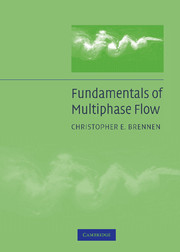Book contents
- Frontmatter
- Contents
- Preface
- Nomenclature
- 1 Introduction to Multiphase Flow
- 2 Single-Particle Motion
- 3 Bubble or Droplet Translation
- 4 Bubble Growth and Collapse
- 5 Cavitation
- 6 Boiling and Condensation
- 7 Flow Patterns
- 8 Internal Flow Energy Conversion
- 9 Homogeneous Flows
- 10 Flows with Bubble Dynamics
- 11 Flows with Gas Dynamics
- 12 Sprays
- 13 Granular Flows
- 14 Drift Flux Models
- 15 System Instabilities
- 16 Kinematic Waves
- Bibliography
- Index
16 - Kinematic Waves
Published online by Cambridge University Press: 05 June 2014
- Frontmatter
- Contents
- Preface
- Nomenclature
- 1 Introduction to Multiphase Flow
- 2 Single-Particle Motion
- 3 Bubble or Droplet Translation
- 4 Bubble Growth and Collapse
- 5 Cavitation
- 6 Boiling and Condensation
- 7 Flow Patterns
- 8 Internal Flow Energy Conversion
- 9 Homogeneous Flows
- 10 Flows with Bubble Dynamics
- 11 Flows with Gas Dynamics
- 12 Sprays
- 13 Granular Flows
- 14 Drift Flux Models
- 15 System Instabilities
- 16 Kinematic Waves
- Bibliography
- Index
Summary
Introduction
The one-dimensional theory of sedimentation was introduced in a classic article by Kynch (1952), and the methods he used have since been expanded to cover a wide range of other multiphase flows. In Chapter 14 we introduced the concept of drift flux models and showed how these can be used to analyze and understand a class of steady flows in which the relative motion between the phases is determined by external forces and the component properties. The present chapter introduces the use of the drift flux method to analyze the formation, propagation, and stability of concentration (or kinematic) waves. For a survey of this material, the reader may wish to consult Wallis (1969).
The general concept of a kinematic wave was first introduced by Lighthill and Whitham (1955) and the reader is referred to Whitham (1974) for a rigorous treatment of the subject. Generically, kinematic waves occur when a functional relation connects the fluid density with the flux of some physically conserved quantity such as mass. In the present context a kinematic (or concentration) wave is a gradient or discontinuity in the volume fraction, α. We refer to such gradients or discontinuities as local structure in the flow; only multiphase flows with a constant and uniform volume fraction are devoid of such structure. Of course, in the absence of any relative motion between the phases or components, the structure is simply convected at the common velocity in the mixture.
- Type
- Chapter
- Information
- Fundamentals of Multiphase Flow , pp. 302 - 320Publisher: Cambridge University PressPrint publication year: 2005



